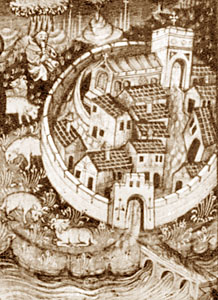 Medieval English urban history - Introduction:
Medieval English urban history - Introduction: The vast majority of the primary sources that bear witness to medieval English towns and the lives of the men and women who resided in them each focus on some particular aspect or event. General descriptions of any individual towns are rare, as are surveys or reviews of English towns generally. We do possess a few examples of these, however, and several are given here. Two happen to be roughly contemporary with each other, from the period when we are just beginning to see boroughs emerging as distinctive entities in the social and economic fabric. Furthermore, they present contrasting viewpoints on urban society: one pro, one con. The third comes at the close of the Middle Ages, while the fourth is a century later yet looks back at a city as it was in the medieval period. A fifth document (actually the fourth in the sequence below) is not in the same mould, but has been included for the light it throws upon key characteristics of towns in medieval England.
Most of the medieval texts presented in the Florilegium Urbanum almost inevitably date from the thirteenth to fifteenth centuries – the final third of what is conventionally considered the European Middle Ages. This is due to a dearth of surviving written documentation produced by urban sources in earlier periods.




